Pump Handbook by Igor J. Karassik, Joseph P. Messina, Paul Cooper, Charles C. Heald - 3rd edition
Подождите немного. Документ загружается.

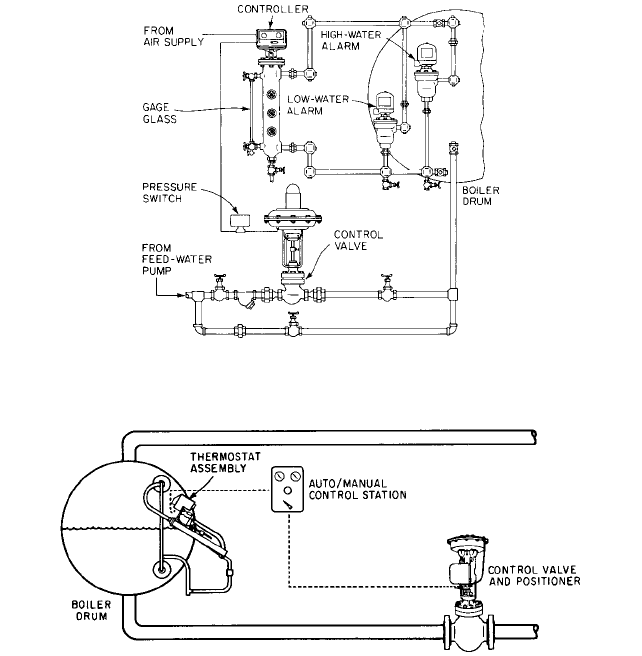
7.12 CHAPTER SEVEN
FIGURE 13 Boiler water level control system. In the controller, an external magnet senses position of displacer
(Magnetrol).
FIGURE 14 Single-element boiler feedwater regulator system (Copes-Vulcan)
For low-pressure boilers operating on moderate loads at no higher than 600 lb/in
2
(41
bar) gage and usually far below, on-off control of constant-speed pumps is sometimes used.
The control can be similar to a low-water cutoff device actuated by float, but it has two
switches: the switch at the higher water level is for level control, and the one below is for
low-water cutoff of fuel and for alarm. Level differences of 1 to 3 in (2.5 to 7.6 cm) start the
pump. This type of control can have a third switch, installed to give a separate alarm for
low water before the fuel cutoff.With fire-tube boilers, the third switch can give a separate
high-water alarm if the pump does not stop when the pump cutout switch is actuated.
Regulators directly actuated by float are also in use. Valves for these regulators are
usually two-seated to reduce the thrust required of the float and linkage mechanism.
Boiler pressures are low for this method, below 250 lb/in
2
(17 bar), although the regulators
can be built to withstand 600 lb/in
2
gage (41 bar). Capacities go to more than 400,000 lb/h
(180,000 kg/h) at pressure drops of 100 lb/in
2
(7 bar) across the valve.
For more demanding service, modulating control by means of an amplified signal
applied to a valve actuator is necessary. The simplest type of modulating control of this
kind is a single-element regulator, serving for fairly constant loads and pressures (Figures
13 and 14). In the pneumatic system, a change of water level in the boiler drum provides
a pneumatic output signal that is transmitted to a controller supplying air pressure to the
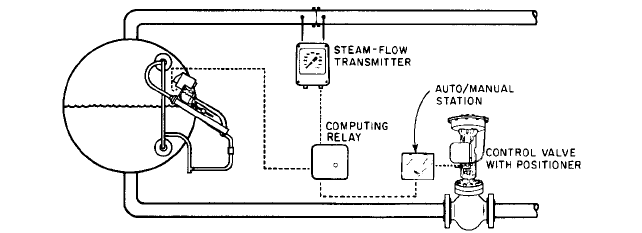
7 PUMP CONTROLS AND VALVES 7.13
diaphragm or piston actuator of a control valve in the discharge line from the feedwater
pump. A sensing thermostat for drum water level may be designed as a proportional con-
troller, with gain changing in proportion to deviation from the set point. Linkage trans-
fers the elongation of the sensing element to the pneumatic transmitter. Torque tubes or
magnetic couplings (Figure 13) may also convert the water level sensing of a float or dis-
placer to a pneumatic signal, in any of the standard pressure ranges. The air pressure
required for the feedwater control valves must usually be at least 50 lb/in
2
gage (3.4 bar),
and up to 125 lb/in
2
(8.6 bar) gage may be necessary. Balanced-trim valves do not require
as high air pressures as do the unbalanced-plug type, and the small amount of leakage is
not harmful.
In some single-element systems, the sensing element directly actuates the valve. In one
system of this type, a high enough vapor pressure is produced in an enclosed tube to oper-
ate the feedwater control valve directly. The vapor pressure generator consists of a slant-
ing inner tube mounted beside the boiler drum, with ends connected on top and bottom of
the drum. A finned outer tube, filled with a liquid and connected only to the control valve
actuator, envelops the inner tube. A decrease in water level brings more heating steam into
the inner tube to warm the liquid in the outer tube and increase its vapor pressure. The
vapor pressure is transmitted to the valve actuator to open to the valve.
In an electric control system, the level sensor can emit a signal modified by a slidewire
potentiometer. The valve operator is an electric motor. In the larger sizes, the valve actu-
ating speed will be low, so the system cannot respond quickly to rapid change in steaming
rate and water level.
Some single-element systems employ a pressure control valve directly upstream of the
main feedwater control valve. The upstream valve, called a differential valve, maintains a
constant pressure on the feedwater control valve, improving its performance. Pressure
control valves of this type have been used on some more advanced systems, too.
Single-element systems are inadequate for a boiler whose steaming rate changes sud-
denly because of the anomalous behavior of the water level during the change. A sudden
demand for steam will reduce pressure in the drum, and steam bubble formation will
increase, temporarily raising the water level at precisely the time when a falling level is
required to signal for increased feedwater flow. The anomaly is called a rising water level
characteristic. If the steaming rate change is gradual, the characteristic can be constant
or even lowering.
The two-element regulator (Figure 15) solves this problem by sensing steam flow
through an orifice in the steam main. The flow rate signal goes to the controller, and a sud-
den increase in steam flow will temporarily override the spurious water level signal.
Three-element control (Figure 16) offers a further refinement
—
it senses feedwater
flow rate in addition to water level and steam flow rate. During a rapid and large load
swing, the feedwater flow rate can then be adjusted to the steam flow rate, while the water
level is simultaneously noted. The feedwater flow rate signal is converted to a linear sig-
nal for transmission to a computing relay that can be adjusted for the relative influences
FIGURE 15 Two-element regulator system with steam flow measurement (Copes-Vulcan)
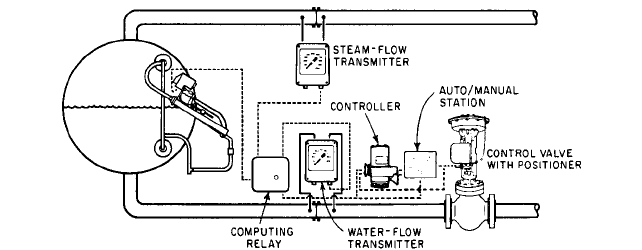
7.14 CHAPTER SEVEN
FIGURE 16 Three-element regulator system action depends on water level, steam flow, and feedwater flow
(Copes-Vulcan).
of the three variables. A balanced signal then goes to the drum level controller, whose air
output actuates the control valve.Three-element control systems can eliminate the effects
of pressure variations upstream of the regulating valve.
BUILDING-WATER PRESSURE CONTROL In tall buildings or large industrial, commercial, or
housing water systems, water pressure can be maintained in several ways. If elevated or
pressure tanks are not desired, a multiple-pump system may be considered. The pumps
can be constant-speed or variable-speed. For constant-speed pumps, pressure sensors
bring in individual pumps as required to maintain pressure. If a large number of pumps
are necessary, means must be provided to prevent all of them from starting simultane-
ously on restoration of power after a failure. (See Section 9.21.)
Hydropneumatic systems rely on air pressure in the top of a tank into which pumps
deliver water intermittently. As water is drawn off, the air expands, reducing its pressure
and eventually requiring another pump start. Both pressure and water level are sensed.
If the pump liquid does not bring in enough air to the tank to make up for losses, an air
compressor or the compressed-air system must supply air. Tank pressure after each level-
controlled pumping cycle indicates whether more air is needed or whether air should be
bled off. Float or probe sensors can determine liquid level, and various pressure sensors
are available.
VALVES_____________________________________________________________
For the final control element, conventional and traditional valves serve for on-off control
in pump systems.They also cover much of the modulation need. In recent years, modulat-
ing control in demanding services has required development of special control valves, actu-
ators, and accessories. System dynamic characteristics, corrosion, erosion, noise, and costs
have influenced the development.
Operation and Valve Types The on-off operation of pump valves serves for
1. Isolation of a pump: protection, maintenance, removal, administrative reasons
2. Bypass or partial isolation: inlet or outlet block for protection, improved flow control,
administrative reasons
3. Pressure relief: protection
4. Venting: removal of gases and vapors from the casing
5. Draining: removal of liquids from the casing
7 PUMP CONTROLS AND VALVES 7.15
The modulating mode of operation services for
1. Control of flow rate to pump or of pressure at inlet
2. Control of delivered flow rate or pressure
3. Control of bypass flow rate
Auxiliary flows in lines to packing boxes, seals, and sensing or measuring elements are
controlled by either on-off or modulating valves.
The principal types of valves for on-off and much modulating service are
• Gate (rare for modulating)
• Globe (and angle)
• Butterfly
• Ball
• Eccentric butterfly
• Plug
• Diaphragm
Check valves and relief valves, although possessing design features peculiar to their
nature, make use of the essential features of globe and butterfly valves.
Control valves have developed as a special group for demanding services that require
wide modulation range, stability, wear resistance, low noise, or a specific flow characteris-
tic. Ingenuity and experience have combined to evolve many unusual but effective designs,
each with advantages and drawbacks.
Control Valves A control valve is a valve that modulates the flow through it to provide
the desired downstream (or upstream) pressure, flow rate, or temperature. Although most
types of valves can be partly closed and thus give a degree of control that may be accept-
able for many purposes, the term control valve has come to mean a specialized type of
power-actuated valve designed for good performance under steady-state or dynamic flow
conditions.
Before examining various control valves and their reasons for existence, some basic
practical concepts must be reviewed. A control valve includes
1. A body to contain the pressure, direct the liquid flow, and resist loads from piping and
actuation
2. A variable orifice or orifices
3. A steam for positive connection of orifice elements to actuator
4. A piercement through the body wall to allow the steam to pass
5. An actuator to adjust the orifice size
Adaptations of globe valves and angle valves are common. These forms inherently give
tight shutoff. High-quality trim helps resist erosion and wear at low flow rates when the
orifice is nearly closed. Support is often provided for the steam to prevent vibration and
flutter (Figure 17). The plug can be characterized (shaped to give certain rates of flow for
given percentages of opening) as desired. The support of the stem is usually on the bonnet
side of the orifice rather than opposite, to keep orifice size down. With flow upward
(through the orifice, and then past the plug), the actuator must overcome upstream pres-
sure to close the valve. With flow downward (past the plug, and then through the orifice),
valve motion becomes unstable when the valve is nearly closed.
The basic globe valve is often modified to put two orifices and plugs on the same stem,
with the upstream fluid entering the space between and passing in two opposite flows
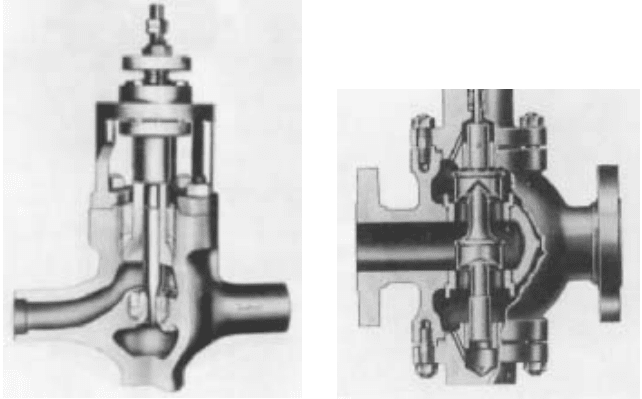
7.16 CHAPTER SEVEN
FIGURE 17 This control valve is basically a globe
type, with reduced trim and guided tapered plug
(Copes-Vulcan).
FIGURE 18 Double-seated control valve with
characterized plugs (Masoneilan International)
through the two orifices. This is the double-seated valve (Figure 18). Actuator force is
greatly reduced because fluid pressure tends to open one plug and close the other. The bal-
ance is not complete, however, because one orifice is usually larger than the other to per-
mit assembly and because there is a difference in head conversion effects in the orifices at
low flow rates.
Addition of an internal diaphragm and a port in the body near one orifice makes the
valve a three-way type, able to divide flow between two outlet lines or, with reversed flow
direction, combine two flows in a desired ratio. The double-seated valve cannot seal tightly
because of manufacturing tolerances and thermal and pressure effects on the valve body.
Butterfly valves can modulate flow (Figure 19). Special vane shapes have been intro-
duced to improve performance. Elastomer or plastomer linings give a tight shutoff on liq-
uids within the temperature range of the materials.
Ball valves as control valves may take conventional form, with an actuator and posi-
tioner atop the valve. In other designs, the ball may be merely a fraction of a spherical
shell, adequate for sealing on the customary tetrafluoroethylene seat ring but with its
edge shaped to develop the required characterized flow as the shell rotates and exposes
the orifice. Convex, V-notch, and parabolic edge shapes find use. The conventional ball
valve has two variable orifices in series, of course, with a small chamber between them in
which some head recovery occurs as fluid momentarily slows.
A specialized form of gate valve can serve as a control valve. This type contains a
multiple-orifice plate mounted permanently as a diaphragm perpendicular to the line of
flow (Figure 20). The “disk,” a plate that also contains two or more slotted orifices, is
mounted to slide vertically across the upstream side of the stationary plate. The degree of
orifice coincidence determines the flow rate. Actuation is by a pin mounted on the stem
and protruding through the stationary plate into a pocket on the sliding plate. Low vibra-
tion and straight-through flow are characteristic of this valve. The actuating force is low
at all flow rates because of the sliding action of the lapped disk and plate and because of
the disk support. Both disk and plate are made of stainless steel or other alloys.
CAGE VALVES This type has developed into an entire group of control valves (Figures 21
to 25). The valve body closely resembles that of the globe valve, with a large orifice in a
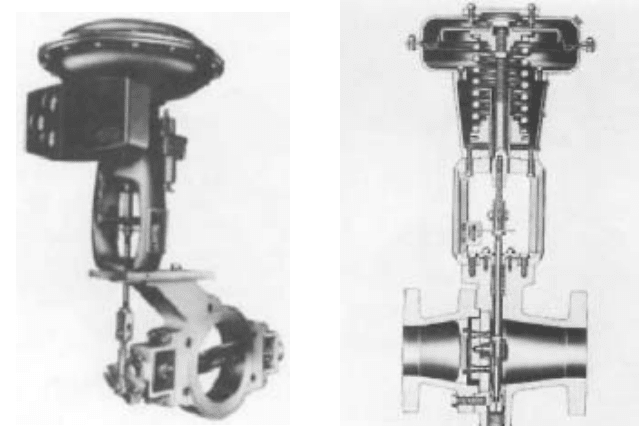
7 PUMP CONTROLS AND VALVES 7.17
FIGURE 19 Butterfly control valve with linkage
connecting spindle to diaphragm actuator and
positioner (Masoneilan International)
FIGURE 20 Movement of one plate past another
opens or closes flow orifices in this control valve
(Jordan Valve Division, Richards Industries).
horizontal area of the central diaphragm. The cage is a hollow cylinder that is held
between the bonnet and the edge of a hole in the diaphragm. The disk or plug, sliding up
and down inside the cage, is guided by it.
In most cage valves, the lower zone of the annular cage is available for flow control ori-
fices, alternately exposed and covered as the plug moves up and down (Figure 21). Tight
shutoff at these orifices is impossible, of course, and so the bottom of the cage or a separate
seat ring is machined and finished to match a seating surface on the plug.
In other cage valves, where the plug may be much smaller than the cage inside diam-
eter (Figure 22), all control action is at the lower seat ring. The plug guiding is then on the
stem or in the seat ring orifice, and the holes in the cage are merely passage holes to dis-
tribute the liquid evenly around the perimeter.
The seat ring in cage valves is retained by bonnet bolting forces acting through the
cage. Gaskets take up tolerances in dimensions and finish, so the seat ring need not be
pressed or screwed into the valve diaphragm.
The ordinary cage valve has several advantages. Suitable machining of cage holes can
give the valve the desired characteristics. Removal and replacement of internals, such as
cage and seat ring, are quick and simple.A vertical hole through the plug makes the valve
nearly balanced (Figure 23), although considerable leakage can occur between plug and
cage wall if the plug is balanced in this way. Cage wall orifices vary not only in number,
size, and cross-sectional form, but also in path and surface roughness.
In one advanced variation of the cage valve, the cage wall is comparatively thick and
the many pathways through it are labyrinthine, with several right-angle turns and several
orifices and expansion chambers in each pathway (Figure 26). To make the cage practical
from a manufacturing standpoint, it consists of a series of thin disks each carrying a pat-
tern of labyrinthine paths in one surface.The opposite surface is flat, so when the disks are
stacked into a cage, the paths are sealed from one another. Flow in valves of this type can
be from inside or outside the cage. Characterization is possible by such means as a change
in the number of orifices per disk at various heights in the stack. As in conventional cage
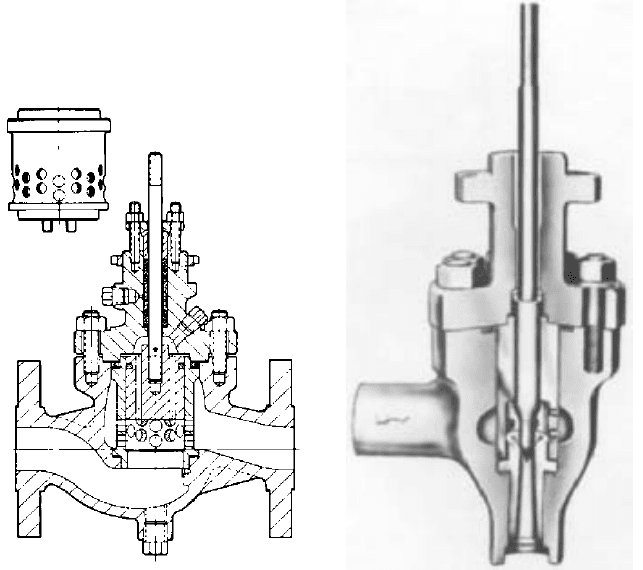
7.18 CHAPTER SEVEN
FIGURE 21 Hole pattern in cage can reduce noise
and cavitation (ITT Hammel Dahl Conoflow).
FIGURE 22 Tapered outlet section improves flow
pattern in this cage valve (Copes-Vulcan).
valves, the trim and characterization can be quickly changed after bonnet removal. The
bonnet bolting, outside the liquid, holds the cage elements in place.
In other cage valves, the passage walls may be wavy, resembling screw threads. This
assists in noise reduction in gas valves.
MULTIPLE ORIFICES IN SERIES Several valves have orifices in series rather than in parallel;
the principle is called cascading. In one group, a tapered plug with a series of circumfer-
ential serrations moves in a tapered seat that may be either conical or stepped (Figures
27 and 28). In either case, the serrations or steps produce a series of small annular cham-
bers alternating with annular restrictions that serve as orifices. Some alternating change
in flow direction also occurs to create the desired head loss.
In another group, annular chambers in the wall of a cylindrical cage are separated
from one another by ridges that are a close fit with annular ridges on a sliding plug. The
orifices narrow as the ridge sets approach one another, whereas the expansion chambers
remain nearly constant in size. Repeated change in flow direction and speed produces
head loss. In a variation of this type (Figure 29), the chambers on the cylindrical plug are
short, steeply angled helical cuts, so the liquid takes a helical path. The purpose is to fling
the liquid against the walls of the cage and displace cavitation bubbles toward the center
and away from wall contact. Shutoff in these valves cannot rely on the multiple-orifice sys-
tems, but instead depends on a separate conventional seat and plug surface, either
upstream or downstream of the orifice system.
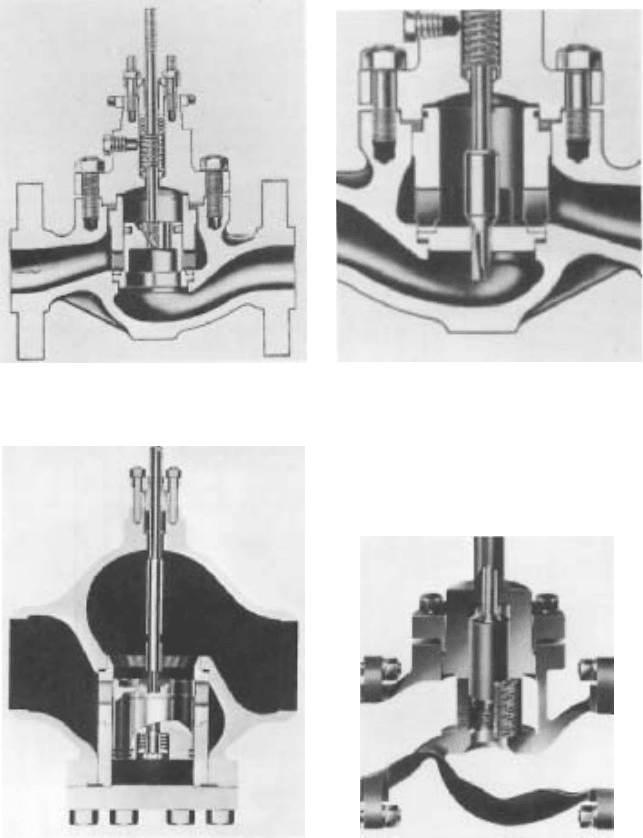
7 PUMP CONTROLS AND VALVES 7.19
FIGURE 23 Holes in plug allow pressure balance in
this cage valve (Fisher Controls).
FIGURE 24 An extreme in reduced trim for a cage
valve (Fisher Controls)
FIGURE 26 Control valve with flow through
labyrinthine orifices in built-up cage (Control
Components)
FIGURE 25 Cage valve with bottom access (Copes-
Vulcan)
Many of these special valves are very expensive because of the multiplicity of compli-
cated parts and because of the reduction in capacity caused by the advanced design.
Larger bodies and overall sizes are required for a given flow rate. In pump control, the
valves see service on high-pressure feedwater pump minimum-flow recirculating lines,
where pressures go as high as 6000 lb/in
2
(400 bar) and water temperatures range to
500°F (260°C). Tight shutoff over thousands of operating cycles is the goal.
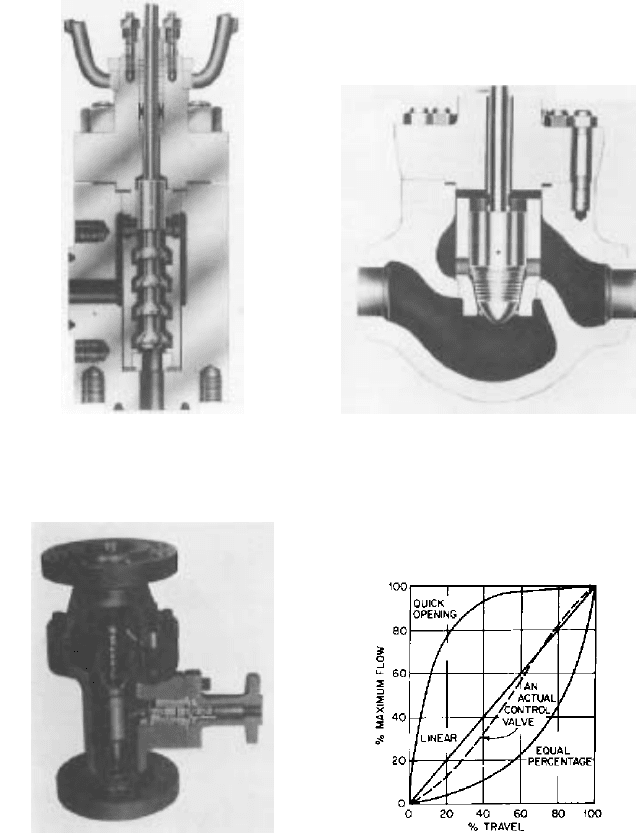
7.20 CHAPTER SEVEN
FIGURE 27 Pressure breakdown occurs across
several annular orifices and direction changes in this
valve (Masoneilan International).
FIGURE 28 Serrations on large plug give high
pressure drop at low flow (Copes-Vulcan).
FIGURE 29 Pump bypass flow at high pressure drop
results when line flow at top ceases and mechanism
opens valve at right (Yarway).
FIGURE 30 Basic control valve characteristics.
Valves are designed to approach these.
FLOW CHARACTERISTICS
An important parameter for valves in modulating control is the
flow characteristic of the valve, often called simply the characteristic. The flow charac-
teristic expresses the way in which the flow through the valve depends on percentage of
valve stem travel. The latter may be translatory or rotary motion, of course. A plot of per-
centage of maximum flow at various percentages of stem travel is the usual quantitative
way of showing a characteristic (Figure 30). Several types of characteristics have become
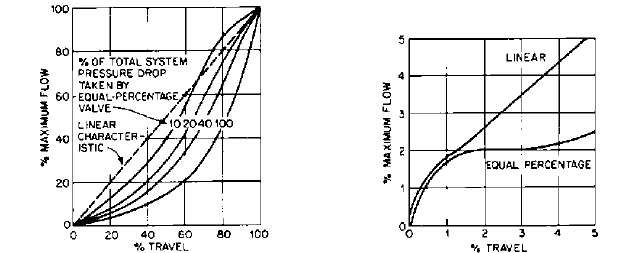
7 PUMP CONTROLS AND VALVES 7.21
common, either because of inherent desirability or because familiar and traditional types
of valves have them.
The linear characteristic is a straight line, with flow percentage always equal to stem
travel percentage. A quick-opening characteristic, on the other hand, produces propor-
tionately more flow in the early stages of stem travel. An equal-percentage characteristic
gives a change that, for a given percentage of lift, is a constant percentage of the flow
before the change. A change of 16% of total stem travel will double the flow, so at a stem
travel of about 84%, flow will be 50% of maximum.
Although the linear characteristic would seem best because the rate of flow change is
uniform for a given stem travel change, incorporation of the valve into a piping system
affects the decision. Because resistance to flow in a given piping system is roughly pro-
portional to the square of the flow rate, the curve of the piping system head loss plotted
against flow rate will be a parabola, with resistance increasing at a faster rate than flow.
If the piping system and valve are considered together and the flow rate in the system
plotted against percentage of valve stem travel, the overall system characteristic will dif-
fer from the valve characteristic. The overall system characteristic is displaced upward
toward the quick-opening valve characteristic but can have points of flexure. The amount
of displacement depends on what part of the total system pressure drop is taken by the
valve. Only with a very short outlet pipe would the valve take all the pressure drop, and
then its characteristic would be that of the system.
In many systems, the pressure drop across the valve is designed to be from one-tenth
to one-third of the total system drop. If the valve in such a system has an equal-percentage
characteristic, the characteristic of the overall system will be close to linear as far as the
actuator of the valve is concerned (Figure 31).
The equal-percentage characteristic is obtained by such measures as contouring the
valve plug, contouring slots in plug skirt or cage, or suitably spacing holes in the cage.
Valves with a characteristic between linear and equal-percentage are also useful in
modulating control. Ball, plug, and butterfly valves are examples. Characterized ball and
plug valves are examples of modifications for control characteristic purposes.
RANGEABILITY Control valve rangeability (Figure 32) can be important in some cases; it
is defined as the ratio of maximum flow to minimum flow at which the valve character-
istic is still evident and control is possible. A high rangeability value means that a single
valve can handle low as well as high flows, so auxiliary valves are unnecessary. The best
performance in this regard is about 100:1 for special designs under favorable circum-
stances, and 25:1 is common for conventional valves and ordinary circumstances.
Connected with rangeability is valve gain, which is the slope of the flow characteristic
curve at any point. In practical terms, valve gain is the change in flow rate per unit of
FIGURE 31 For a valve in a system, the overall
characteristic depends on valve characteristic and
pressure breakdown.
FIGURE 32 Rangeability of a valve is determined by
the point at which valve characteristic is still evident,
between 1 and 2% of maximum flow for the two valve
characteristics shown here.
